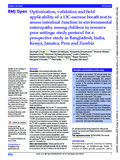| dc.contributor.author | Lee, Gwenyth O. | |
| dc.contributor.author | Schillinger, Robert | |
| dc.contributor.author | Shivakumar, Nirupama | |
| dc.contributor.author | Sherine, Whyte | |
| dc.contributor.author | Huq, Sayeeda | |
| dc.contributor.author | Konyole, Silvenus Ochieng | |
| dc.contributor.author | Chileshe, Justin | |
| dc.contributor.author | Olortegui, Maribel Paredes | |
| dc.contributor.author | Owino, Victor | |
| dc.contributor.author | Yazbeck, Roger | |
| dc.contributor.author | Kosek, Margaret N | |
| dc.contributor.author | Kelly, Paul | |
| dc.contributor.author | Morrison, Douglas | |
| dc.date.accessioned | 2022-01-10T09:41:10Z | |
| dc.date.available | 2022-01-10T09:41:10Z | |
| dc.date.issued | 2021-11-17 | |
| dc.identifier.uri | https://doi.org/10.1136/bmjopen-2019-035841 | |
| dc.identifier.uri | https://bmjopen.bmj.com/content/10/11/e035841 | |
| dc.identifier.uri | http://ir-library.mmust.ac.ke:8080/xmlui/handle/123456789/2008 | |
| dc.description.abstract | Introduction Environmental enteropathy (EE) is suspected to be a cause of growth faltering in children with sustained exposure to enteric pathogens, typically in resource-limited settings. A major hindrance to EE research is the lack of sensitive, non-invasive biomarkers. Current biomarkers measure intestinal permeability and inflammation, but not the functional capacity of the gut. Australian researchers have demonstrated proof of concept for an EE breath test based on using naturally 13C-enriched sucrose, derived from maize, to assay intestinal sucrase activity, a digestive enzyme that is impaired in villus blunting. Here, we describe a coordinated research project to optimise, validate and evaluate the usability of a breath test protocol based on highly enriched 13C-sucrose to quantify physiological dysfunction in EE in relevant target populations.
Methods and analysis We use the 13C-sucrose breath test (13C-SBT) to evaluate intestinal sucrase activity in two phases. First, an optimisation and validation phase will (1) confirm that a 13C-SBT using highly enriched sucrose tracers reports similar information to the naturally enriched 13C-SBT; (2) examine the dose–response relationship of the test to an intestinal sucrase inhibitor; (3) validate the 13C-SBT in paediatric coeliac disease (4) validate the highly enriched 13C-SBT against EE defined by biopsy in adults and (5) validate the 13C-SBT against EE defined by the urinary lactulose:rhamnose ratio (LR) among children in Peru. Second, a cross-sectional study will be conducted in six resource-limited countries (Bangladesh, India, Jamaica, Kenya, Peru and Zambia) to test the usability of the optimised 13C-SBT to assess EE among 600 children aged 12–15 months old.
Ethics and dissemination Ethical approval will be obtained from each participating study site. By working as a consortium, the test, if shown to be informative of EE, will demonstrate strong evidence for utility across diverse, low-income and middle-income country paediatric populations. | en_US |
| dc.language.iso | en | en_US |
| dc.publisher | BJM | en_US |
| dc.subject | Optimisation, validation, field, applicability,13C-sucrose, breath, test, assess, intestinal, function, environmental, enteropathy, among, children, resource, poor, settings,study, protocol, prospective | en_US |
| dc.title | Optimisation, validation and field applicability of a 13C-sucrose breath test to assess intestinal function in environmental enteropathy among children in resource poor settings: study protocol for a prospective study in Bangladesh, India, Kenya, Jamaica, Peru and Zambia | en_US |
| dc.type | Article | en_US |

